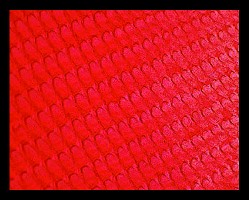
Nutrition
The majority of terrestrial gastropods, including Millerelix simpsoni, are herbivores that get most of their nutrients from the mycelia of various fungal forms (Leonard, 1959). In captivity, these gastropods consume fresh fruit and vegetables like apples, bananas, and lettuce (Leonard, 1959). Since almost all snails reside on the ground, they scoop up any vegetation or decay that they can scavenge, and they do so through various processes and structures as explained below (Leonard, 1959).
In order for Millerelix simpsoni species to get its nutrition, it needs a very essential structure called the radula. As seen in figure 2, the radula has a rough texture useful for grating decay off the ground and sucking it up to digest (Leonard, 1959). The jaw consists of horny plates and is also important in grinding down food (Leonard, 1959). The radula also has transverse and longitudinal rows of teeth that have the appearance of hooks in Figure 2 (Leonard, 1959). The snail uses the radula to pick up the food and the jaw to help in mastication (Leonard, 1959). Also, there is diversity among the types of teeth in gastropoda, which can help in classifying them (Leonard 1959). In terms of location, the radula rests upon a swollen area on the bottom of the buccal cavity, and the horny plates of the jaw are on the upper wall of the oesophagus (Leonard, 1959).
A unique characteristic of gastropods is their ability to perform torsion, something that may affect proper nutrition. Torsion is a stage that takes place during the veliger larval stage in which the gastropod twists its visceral mass 180 degrees to the opposite side (Hickman et al., 2012). Figure 1 above shows the formation of a mantle, shell, and foot in the veliger larvae stage (Gillis, 2012). After torsion, the anus appears above the mouth and head which poses as a difficulty when it comes to proper nutrition (Hickman et al., 2012). This arrangement can result in fouling, which occurs when fecal wastes wash over and contaminate the gills and near the radula where the snail eats (Hickman et al., 2012).
To learn more information about the nutrition of
gastropods, visit the following link:
http://bioweb.uwlax.edu/bio210/s2012/delong_stef/nutrition.htm
Return to Homepage

